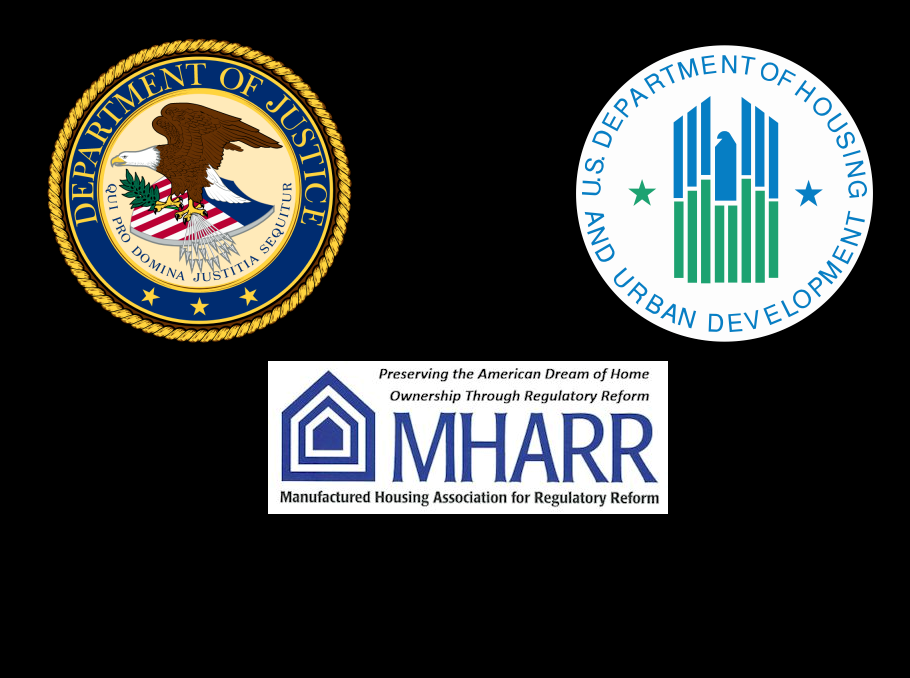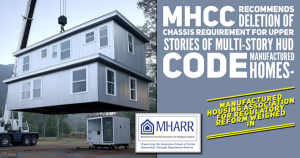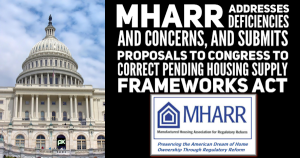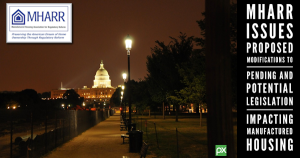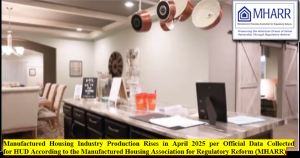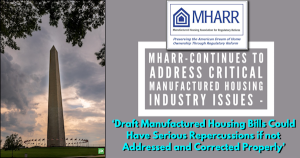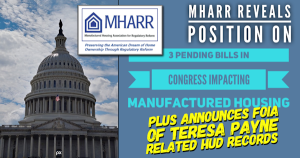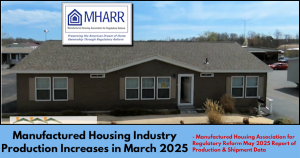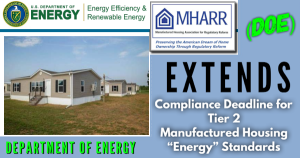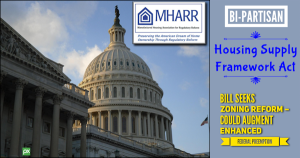[vc_row][vc_column][vc_column_text]FOR IMMEDIATE RELEASE
MHARR CALLS FOR REPEAL OF HUD
MANUFACTURED HOUSING “GUIDANCE” DOCUMENTS
Washington, D.C., April 25, 2018 – The Manufactured Housing Association for Regulatory Reform (MHARR), citing recent rulings by the U.S. Department of Justice (DOJ) stating that DOJ would no longer use its authority to enforce Executive Branch agency “guidance” documents in civil court enforcement actions relating to alleged violations of federal health, safety, civil rights and environmental laws, has called on HUD to formally repeal manufactured housing regulatory “guidance” documents which should have been published for notice and comment and subjected to Manufactured Housing Consensus Committee (MHCC) review pursuant to section 604(b)(6) of the Manufactured Housing Improvement Act of 2000, but were not. MHARR, in the same April 25, 2018 communication (copy attached), also calls on HUD to repeal a 2010 “Interpretive Rule” which erroneously construes section 604(b)(6) of the 2000 reform law to require notice and comment rulemaking and MHCC consensus review onlyfor HUD regulatory actions that would otherwise constitute “rules” within the meaning of the federal Administrative Procedure Act (APA).
For decades, the HUD manufactured housing program used “guidance” and other psuedo-regulatory pronouncements to evade the rulemaking requirements of both the APA and the original Manufactured Housing Construction and Safety Standards Act of 1974. When Congress sought to put an end to this abusive practice by including section 604(b)(6) in the Manufactured Housing Improvement Act of 2000 – which, on its face, requires prior MHCC review and rulemaking for any new or modified “policies, practices or procedures” relating to “standards, regulations, inspections, monitoring or other enforcement activities” – HUD promptly ignored Congress’ clear directive, ultimately issuing the 2010 Interpretative Rule, which effectively and unlawfully read section 604(b)(6) out of the law, by limiting its application to “rules” that already require rulemaking under the APA.
This action to negate the clear and unambiguous will of Congress (with the passive acceptance of some within the industry), effectively opened the floodgates to a train of ever-increasing abuses during the Obama Administration – and particularly under the tenure of former program Administrator Pamela Danner – which saw multiple new, costly and needlessly burdensome defactoregulatory mandates imposed by HUD via “field guidance” and so-called “Standard Operating Procedures,” which were never brought to the MHCC for prior review, or published for notice and comment. These include, but are not limited to: HUD’s massive expansion and re-direction of in-plant regulation; “frost-free” foundation “guidance,” which effectively modified an existing regulation; new and modified requirements for attached garages and other “add-ons;” baseless restrictions on multi-family manufactured housing; and memoranda relating to on-site completion, among other things. Such actions – and many other similar pseudo-regulatory mandates — have significantly harmed both manufacturers (particularly smaller independent producers) as well as the industry’s post-production sector, by needlessly increasing regulatory compliance costs and simultaneously undermining the industry’s ability to compete with other segments of the housing market. Through these devices, and through the unchecked and unaccountable activities of its program “monitoring” contractor (set forth in a non-competitive contract which itself violates multiple aspects of federal law), HUD has developed – and enforces — an entire secondary tier of unlawful mandates under the guise of “interpretations” and “guidance.”
Recognizing the extremely damaging effects of such psuedo-regulation and reflecting the regulatory reform policies of the Trump Administration, the DOJ, in its rulings issued on November 16, 2017 and January 25, 2018, determined that it will no longer “use noncompliance with guidance documents as a basis for proving violations of applicable law” in civil lawsuits to enforce federal health and safety laws, such as the National Manufactured Housing Construction and Safety Standards Act of 1974, as amended by the Manufactured Housing Improvement Act of 2000. To the extent that HUD’s manufactured housing “guidance” documents conflict with this ruling and Trump Administration regulatory policy, MHARR’s April 25, 2018 communication calls for their retraction and repeal as part of HUD’s Executive Order (EO) 13771/13777 “top-to-bottom” regulatory review of the federal manufactured housing program. Similarly, insofar as the DOJ rulings show that HUD’s 2010 Interpretive Rule is fundamentally erroneous and fatally flawed, MHARR’s communication calls once again for the repeal of that rule.
In Washington, D.C., MHARR President and CEO, Mark Weiss, stated: “The Justice Department, which is charged with bringing civil actions to enforce federal health and safety laws, has now made it crystal clear that HUD may not use sub-regulatory ‘guidance’ documents that have not been considered by the MHCC and have not gone through rulemaking, in order to impose new or modified mandates on manufacturers of HUD Code homes, and new unnecessary costs on manufactured home purchasers. The tragedy is that Congress itself said exactlythe same thing nearly two decades ago when it included section 604(b)(6) in the Manufactured Housing Improvement Act of 2000. The time has come for HUD to finally obey the law as written, and its ongoing EO 13771/13777 review of all existing and pending regulations and “regulatory actions” offers the perfect opportunity for HUD to formally renounce both the fatally-flawed 2010 “Interpretive Rule” and its pile of invalid pseudo-regulatory “guidance” documents – before the Justice Department, or a federal judge, does it for them.”
The Manufactured Housing Association for Regulatory Reform is a Washington, D.C.-based national trade association representing the views and interests of independent producers of federally-regulated manufactured housing.


April 25, 2018
Ms. Dana Wade
Acting FHA Commissioner and General Deputy
Assistant Secretary for FHA
Suite 9100
U.S. Department of Housing and Urban Development
451 7thStreet, S.W.
Washington, D.C. 20410
Re: Repeal of HUD February 5, 2010 “Interpretive Rule” and Related
HUD Manufactured Housing Sub-Regulatory “Guidance” Documents
Dear Ms. Wade:
On February 20, 2018, the Manufactured Housing Association for Regulatory Reform (MHARR), on behalf of its members, filed written comments in HUD Docket FR-6075-N-01, the Department’s review of manufactured housing regulations and related “regulatory actions” pursuant to Executive Orders (EO) 13771 (“Reducing Regulation and Controlling Regulatory Costs,” January 30, 2017) and 13777 (“Enforcing the Regulatory Reform Agenda,” February 24, 2017).[1]Among other things, MHARR, in those comments,[2]seeks the repeal of a HUD Interpretive Rule issued on February 5, 2010,[3]without opportunity for prior public comment, which purports to construe section 604(b)(6) of the Manufactured Housing Improvement Act of 2000 (2000 reform law) (42 U.S.C. 5403(b)(6)) to exempt from pre-implementation consensus committee review and mandatory notice and comment rulemaking under that law, a wide range of manufactured housing program regulatory actions that do not meet the definition of a “rule” contained within the Administrative Procedure Act (APA). Since those comments were filed, however, MHARR has learned of additional authority from the U.S. Justice Department and Attorney General[4]which demonstrates: (1) that the February 5, 2010 HUD “Interpretive Rule” represents a fundamentally erroneous misstatement of applicable law that must be withdrawn; and (2) that all“non-rule” regulatory actions within the federal manufactured housing program taken by HUD pursuant to that 2010 “Interpretive Rule,” without prior Manufactured Housing Consensus Committee (MHCC) review and notice and comment rulemaking as mandated by section 604(b) of the 2000 reform law (i.e., “guidance” documents, “field guidance” documents, new or amended “interpretations” of the Part 3280 standards and/or the Part 3282 Procedural and Enforcement Regulations (PER) – otherthan “Interpretative Bulletins” issued pursuant to notice and comment and prior MHCC review — among other things), are null, void, and unenforceable, and should be repealed pursuant to EOs 13771 and 13777.
Before turning to an analysis of the Justice Department memoranda and their specific impact with respect to the HUD 2010 “Interpretive Rule,” it must be noted that during the Obama Administration – and particularly during the tenure of the immediate-past Administrator of the HUD manufactured housing program — the 2010 Interpretive Rule was an excuse and rationale for bypassing the MHCC and notice and comment rulemaking for significantchanges to the HUD standards and regulations, opening the floodgates for a multitude of damaging new (and modified) high-cost mandates which totally bypassed the due process procedures mandated by Congress in the 2000 reform law. These mandates include, most significantly, a massive, all-encompassing change in the focus and scope of – and the procedures utilized in connection with – in-plant regulation and the in-plant “monitoring” of every HUD-regulated manufactured housing producer. Such changes not only resulted in significant new regulatory compliance costs for both manufacturers and consumers – with virtually no corresponding benefits – but also substantially increased the illegitimate regulatory power and reach of the program’s entrenched 40-year-plus “monitoring” contractor. The results of this illicit circumvention of applicable due process protections are evident from MHARR’s previously-filed EO 13771/13777 regulatory review comments. To put the federal program back on track and to restore its functionality and compliance with all applicable law, it is essential, for the reasons more fully explained below, to eliminate both the 2010 “Interpretive Rule” and the illegitimate regulatory actions that have followed from it.
The 2000 reform law added section 604(b)(6) to the original National Manufactured Housing Construction and Safety Standards Act of 1974 (1974 Act) in order to halt HUD’s abuse of sub-regulatory “guidance” letters, memoranda, and other similar unilateral devices,[5]to either add new defactoregulatory mandates to the federal manufactured housing standards and PER regulations – or “interpret” those standards and regulations in such a manner as to add new defactoregulatory mandates – without prior notice and comment in accordance with the APA and federal manufactured housing law. Section 604(b)(6) is thus remedial in nature and intentionally broad in scope, stating that:
“Anystatement of policies, practices, or procedures relating to construction and safety standards, regulations, inspections, monitoring, or other enforcement activities that constitutes a statement of general or particular applicability to implement, interpret, or prescribe law or policy by the Secretary is subject to subsection (a)[6]or this subsection.[7] Any change adopted in violation of subsection (a) or this subsection is void.”
(Emphasis added). Under this clear and unambiguous mandate, allHUD statements, policies, or interpretations of the standards and/or PER regulations which create new regulatory burdens or otherwise change, modify, or alter existing regulatory burdens, mustgo through the regulatory procedure prescribed by section 604(a) or section 604(b) of the 2000 reform law, including prior MHCC consensus review andnotice and comment rulemaking. In this manner, section 604(b)(6) intentionally and specifically exceedsthe requirements of the APA.
While there can be no legitimate debate that Congress has the power and authority to go beyond the APA and subject any such “changes” to “policies, practices, or procedures” to notice and comment rulemaking procedures – andprior MHCC consensus review – even if not denominated (or construed by HUD to be) a “rule” pursuant to the APA, HUD sought to gut this enhanced protective mechanism through its 2010 “Interpretive Rule,” and render it devoid of any substantive meaning in violation of the applicable cannons of statutory construction. Citing nothing more than its facial similarity to language contained in the APA, HUD concluded in that “rule” that “the scope of section 604(b)(6)” includes “onlystatements by HUD that: (1) relate to manufactured housing construction and safety standards, regulations, inspections, monitoring, or other enforcement activities; (2) meet the definition of a ‘rule’ under the APA and applicable case law … and (3) constitute a change from prior HUD statements or practice on the same subject matter.” (Emphasis added). The 2010 HUD “Interpretive Rule,” therefore, construes section 604(b)(6) as requiring notice and comment rulemaking (and MHCC prior review), onlyfor “rules” that would otherwise require notice and comment rulemaking in any event under the APA.[8]
As MHARR has noted previously, however, in February 1, 2012 testimony before Congress on the implementation of the 2000 reform law and in its February 20, 2018 comments to HUD pursuant to its EO 13771/13777 review of all manufactured housing program standards, regulations and regulatory actions:
“[T]o construe section 604(b)(6) to apply onlyto [APA] rules … makes no sense, because such rules are, by definition, alreadysubject to rulemaking and public comment anyway under the … APA…. [S]uch a construction, effectively construing section 604(b)(6) to simply be a restatement of sections 551 and 553 of the APA, violates basic cannons of statutory construction. Given that Congress, in enacting the 2000 reform law is presumed to have been aware of the relevant pre-existing APA sections, such a construction: (1) improperly renders section 604(b)(6) mere surplusage; (2) fails to give (the common and ordinary) meaning to every word and provision of the 2000 reform law; and (3) fails to broadly and liberally interpret a clearly remedial statutory provision.”
(Emphasis added).
Now, though, through pronouncements issued on November 16, 2017 and January 25, 2018, the Justice Department has made it quite clear that the originalmeaning and plain intent of section 604(b)(6) is controllingand that the brazen revisionism inherent in the 2010 HUD “Interpretive Rule” – which would allow substantive changes to the standards and regulations, and their interpretation, and the resulting imposition of new and/or modified regulatory burdens on manufacturers and other regulated parties under the program without eithernotice and comment rulemaking or prior MHCC consensus review, is itself invalid, illegitimate and void.
In relevant part, the November 16, 2017 memorandum from the Attorney General states: “[G]uidance may not be used as a substitute for rulemaking and may not be used to impose new requirementson entities outside the Executive Branch.” (Emphasis added). This is entirely consistent with the originalintent, purpose and language of section 604(b)(6) as enacted by Congress. Similarly, the January 25, 2018 Justice Department memorandum – which expressly extends the scope and reach of the November 16, 2017 memorandum to “guidance” documents issued by Executive Branch agencies beyond the Department of Justice — states, in relevant part: “Guidance documents cannot create binding requirements that do not already exist by statute or regulation. Accordingly, effective immediately for ACE cases,[9]the [Justice] Department may not use its enforcement authority to effectively convert agency guidance documents into binding rules.”
The effect of these memoranda, is to confirm that the 2010 HUD “Interpretive Rule,” is substantively incorrect, invalid and a misstatement of applicable law. The APA, by its express terms, alreadyrequires notice and comment rulemaking for “rules.” Sections 604(a) and 604(b) of the 2000 reform law, expandand clarify this mandate in the specific context of federal manufactured housing regulation by requiring notice and comment rulemaking, as well as prior MHCC consensus review, for proposed manufactured housing standards,[10]PER regulations[11]and Interpretative Bulletins.[12]Section 604(b)(6), then, expands this mandate even further, by separatelyrequiring both rulemaking and prior MHCC consensus review for changes to HUD “policies, practices, or procedures” – including new “policies practices or procedures” – “relating to construction and safety standards, regulations, inspections, monitoring,[13]or other enforcement activities that constitutes a statement of general or particular applicability to implement, interpret, or prescribe law or policy,”[14]regardlessof how any such change is denominated, characterized, depicted, or presented by HUD.
To construe the separate and severable mandate of section 604(b)(6) to apply only to “rules” that would be subject to notice and comment rulemaking in any event under section 553 of the APA – as the 2010 “Interpretive Rule” purports to do — is to render section 604(b)(6) and that mandate devoid of any meaning and effectively strip it out of the 2000 reform law despite Congress’ clear intent to require both consensus procedures and rulemaking for changes that alter the burdens imposed by HUD on regulated parties pursuant to federal manufactured housing law, whether denominated or characterized as “rules” or not. Any such construction would flagrantly exceed HUD’s authority, would unlawfully supplant the lawmaking authority of Congress, would violate the letter and purpose of the 2000 reform law, and would constitute a blatant and unacceptable abuse of HUD’s authority.
Moreover, as is demonstrated by the November 16, 2017 and January 25, 2018 memoranda, the Justice Department would quite properly refuseto enforce any such “guidance” documents, issued without rulemaking and prior MHCC consensus review, as binding mandates on regulated parties in any type of enforcement proceeding sought by HUD, in any event. Accordingly, rather than leaving those unenforceable “guidance” documents on the public record, with their inevitable – albeit unlawful — “interrorem” effect on regulated parties (and corresponding additional regulatory compliance costs needlessly imposed on consumers and manufacturers), those “guidance” documents, as set forth and as stated in MHARR’s February 20, 2018 EO 13771/13777 comments, should be declared null and void in accordance with section 604(b)(6) and formally withdrawn.
In summary, therefore, MHARR asks that HUD, pursuant to its “top-to-bottom” review of all manufactured housing program regulations and “regulatory actions,” not only expressly repeal the February 5, 2010 “Interpretive Rule,” as being contrary to settled law, a clearly erroneous misconstruction of the 2000 reform law, and contrary to Trump Administration regulatory policy as expressed in the aforesaid Justice Department memoranda, but that it also expressly repeal all alleged “guidance” documents issued by the program, except those which merely “explain or paraphrase legal mandates from existing statutes or regulations,” as expressly authorized by the Justice Department’s January 25, 2018 memorandum.
Sincerely,
Mark Weiss
President & CEO
cc: Hon. Mick Mulvaney
Hon. Neomi Rao
HUD Code Industry Manufacturers
[1]MHARR’s February 20, 2018 comments specifically incorporate by reference earlier comments pursuant to EOs 13771 and 13777 that MHARR submitted to HUD on June 7, 2017.
[2]See, MHARR February 20, 2018 Manufactured Housing Regulatory Review comments, at pp. 20-22.
[3]See, 75 Federal Register, No. 24, February 5, 2010, p. 5888
[4]See, Attachment 1 (November 16, 2017 Attorney General Memorandum entitled “Prohibition on Improper Guidance Documents”) and Attachment 2 (January 25, 2018 Justice Department Memorandum entitled “Limiting Use of Agency Guidance Documents in Affirmative Civil Enforcement Cases”), hereto, discussed in greater detail infra.
[5]I.e., defactoregulatory mandates imposed without prior MHCC consensus review and prior opportunity for notice and comment. Examples include, but are not limited to, HUD’s imposition of expanded in-plant monitoring criteria and mandates in 2010, as well as the sub-regulatory “Acceptable Quality Level” (AQL) criteria developed and utilized by HUD’s 40-year-plus “monitoring” contractor as an enforcement mechanism against HUD-regulated manufactured housing producers.
[6]Subsection (a) of section 604 prescribes mandatory procedures for the adoption of Part 3280 standards – i.e., prior consensus committee review and recommendation, and notice and comment rulemaking. See, 42 U.S.C. 5403(a)(4)((B), etseq.
[7]Subsection (b) of section 604 (i.e., “this subsection”) prescribes mandatory procedures for all orders other than those implementing new or amended standards, i.e., “other orders,” including, but not limited to, Part 3282 regulations, “Interpretative Bulletins,” and other “changes” as described in section 604(b)(6). See, 42 U.S.C. 5403(b)(4)(A).
[8]While the three enumerated criteria of the 2010 HUD Interpretive Rule are not expresslyphrased in the conjunctive as summarized at 75 Federal Register, p. 5890, it is clear from the context of the rule as a whole that the three (alleged) predicate criteria for rulemaking are, in fact, intended to be conjunctive, and have been treated as conjunctive by HUD; i.e., all three predicate criteria must be met for HUD to subject an action to rulemaking and prior MHCC review.
[9]The January 25, 2018 memorandum defines “ACE,” or “Affirmative Civil Enforcement” cases, as follows: “’Affirmative civil enforcement’ refers to the Department’s filing of civil lawsuits on behalf of the United States to … impose penalties for violations of federal health, safety, civil rights or environmental laws.” Insofar as the federal manufactured housing law is manifestly a federal “safety” law, an action to enforce Title VI would clearly be an “ACE” action within the meaning of the January 25, 2018 memorandum.
[10]See, note 6, supra.
[11]See, note 7, supra.
[12]Id.
[13]The 2000 reform law added a definition of the “monitoring” function, which was not defined in the original 1974 law. That statutory definition, however, has been consistently ignored by the program, as reflected by the current monitoring contract and the specific functions unlawfully delegated to the monitoring contractor – “’Monitoring’ means the process of periodic review of the primary inspection agencies, by the Secretary or by a State agency… which process shall be for the purpose of ensuring that the primary inspection agencies are discharging their duties under this title.” 42 U.S.C. 5402(20).
[14]Language similar to APA section 553 was utilized in order to distinguish between quasi-legislative program actions – which aresubject to section 604(b)(6), and quasi-judicial program actions, which are notsubject to section 604(b)(6). See, Testimony of the Manufactured Housing Association for Regulatory Reform before the House of Representatives Subcommittee on Insurance, Housing and Community Opportunity, February 1, 2012, at p. 12.[/vc_column_text][/vc_column][/vc_row]

